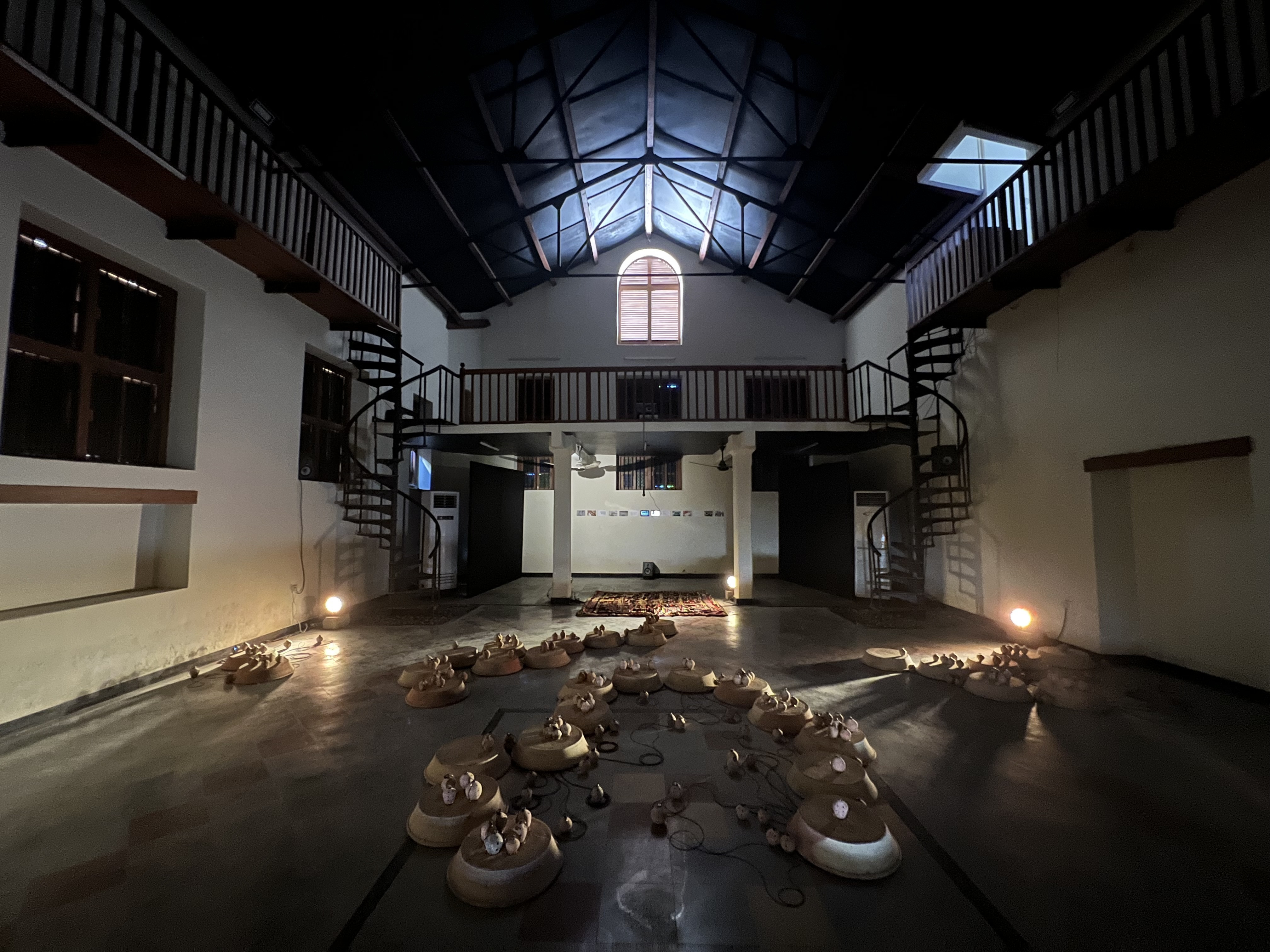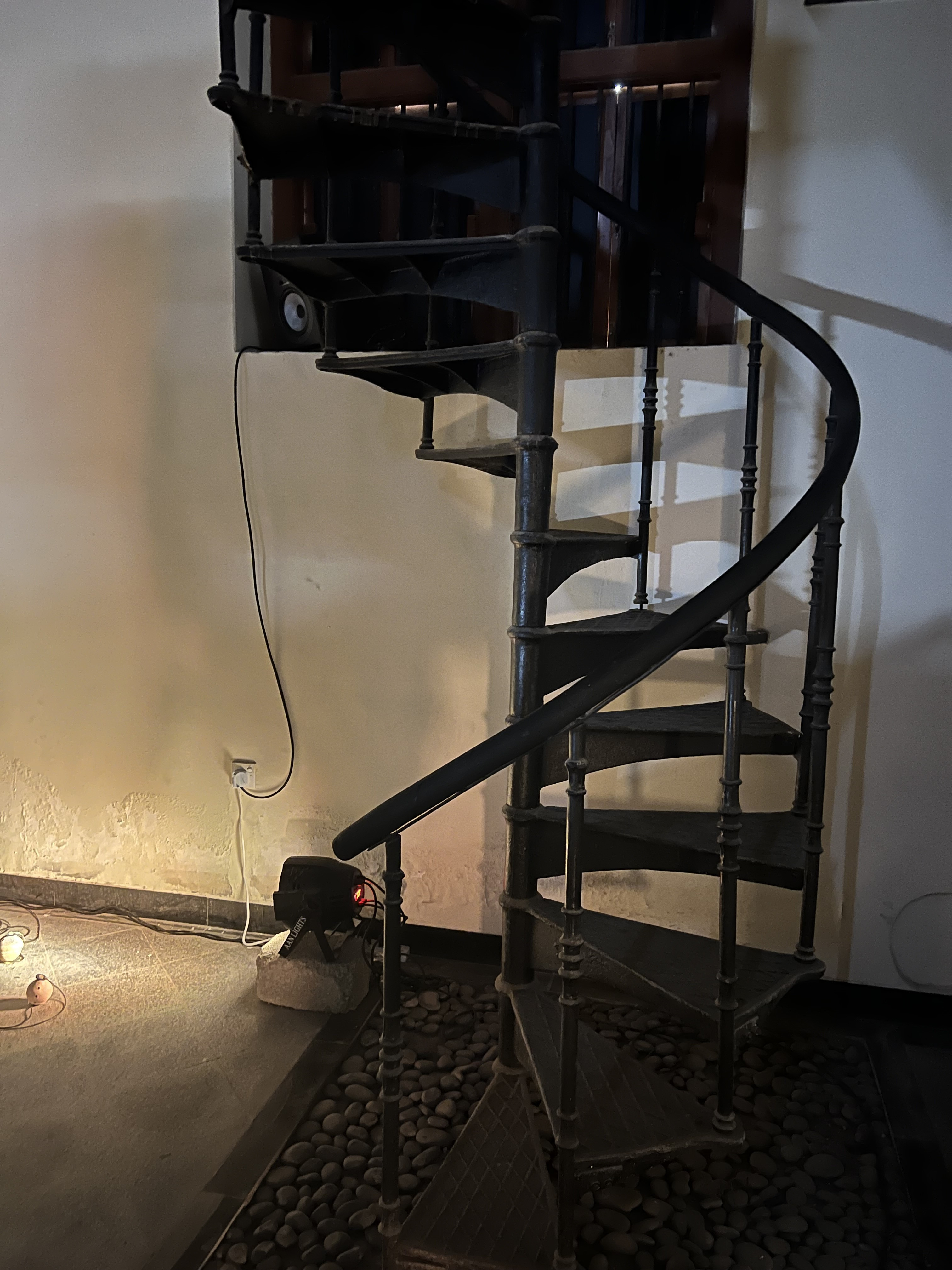Walking down the old structure in the middle of the city, the NED campus itself is a work of art where the Karachi Biennale 2022 installations have been exhibited. Going past the main compound, you reach the backside to a door covered with black curtains. Entrance into the place can be overwhelming; your eyes take a little time to adjust as you enter a dimly lit room, but once you are inside, the aura is mesmerizing.
Connecting art, culture, and history, one installation at the Karachi Biennale 2022 is “Microtonal”, a collaborative art piece by UK’s artist-cum-musician Ben Eaton. “Invisible Flock” by Faqir Zulfiqar and Allah Jurriro is also exhibited. Jurrio is a ninety-year-old potter based in Badin and is one of the few known borindo craftsmen. Zulfiqar, a Sindhi folk musician and maker, plays the borindo and is largely responsible for preserving this localmusical instrument from cultural extinction.
The art installation is formed of two hundred borindos—small pots made of clay or ceramic with three-eight holes in them that are so delicately created they catch a sound from the environment and recreate it in a soothing way. The names given to this flute vary from place to place, and it is spherical or ovoid in shape. You blow into a bigger hole and type into the smaller ones.
The art piece, set up in a huge hall, is accentuated with dim lights. Stairs inside the hall connect to galleries from where a bird's-eye view of the installation is available. Microtonal is an interactive, data-driven sound installation art piece created from two hundred borindos that Jurrio and Zulfiqar made in Badin. “I visited them for the first time in April 2022, and I was mesmerized by the talent. The entire art piece took around one and a half years, as I tuned each borindo by planting a small mic in it, with minor wires connecting each other to produce the sound,” the forty-year-old artist Eaton tells me.

A music lover since his childhood, Eaton says that while researching the art piece, he discovered how people like Jurriro and Zulfiqar are preserving this particular art. Borindo is a five thousand-year-old instrument that was brought back to life through music by Faqir’s father and Jurrio. The work draws on Faqir’s father’s rich cultural and personal connection with the artifacts to examine the hidden symbolism contained in the instrument. Borrindo that looks like a small insect nest goes back thousands of years. It catches sounds from the environment, and the installation has been designed to keep the originality alive,” Eaton shares with me.
Eaton’s first visit to Pakistan was in April when he went to interior Sindh and explored the instrument. When he went back, he started working on what to install in the borindos. “Invisible Flock” produces a certain environment that encourages individuals to reevaluate their emotional connections to the natural world. “The main idea was to explore sounds through technology and keep the culture alive. It has handmade instruments in which small lights and mics are fitted to understand which one is responding to the sound,” he explains.
“Invisible Flock” is a multi-award-winning interactive arts studio that places itself at the intersection of art, technology, and the environment. The installation is designed and placed in several parts of the room to create depth for the sound in various ways. The middle section has more borindos, closely placed, to create more sound waves, while the corner placement has fewer borindos to help create the echo through the sound.
The installation has a mic placed in the middle of the room for those visitors who wish to create a sound and check the installation’s response. The hall has a local touch with a ralli (Sindhi colourful quilt) placed on the floor. Two screens play videos of Zulfiqar and Jurriro making clay pots and Eaton tuning them.
“When I first came up with the idea I was not sure how long I could go with it, but with the collaboration, it has been executed quite well,” says Eaton. The first time it took around three-four months to set up the entire installation, but now it takes about four hours.

Microtonal won the jury award at the inaugural ceremony of the third Karachi Biennale held at the NJV School. The KB22 Juried Art Prize was presented to the UK-based art collective Invisible Flock. This installation was created with the support of the British Council Pakistan-UK New Perspectives Program. The PK-UK Season 2022 is partnering with the Karachi Biennale 2022 to support the production, design, and delivery of two immersive experiential exhibitions at KB22—The Terrarium and Microtone.
KB22, October 31-November 13, is exploring the intersection of art and technology and showcasing exciting and immersive work by artists from Pakistan and thirteen other countries. It is taking place at nine venues across Karachi. The Engro Corporation Limited is the lead partner for this two-week-long event and a major contributor.
The Karachi Biennale Trust’s sustained commitment to recognizing the effort and impact of participating artists and celebrating their enthusiasm and commitment towards their work is acknowledged through the presentation of four awards—Lifetime Achievement Award, Juried Art Prize, Popular Choice Art Prize, and Emerging Artist Prize.
Talking about his visit to Pakistan, Eaton is excited as the weather is pleasant currently. His last trip was in summer, and he travelled to interior Sindh. “I loved the road and watching the landscape change, but it was very hot back then. This time we couldn’t travel to interior Sindh because of the floods.” His favorite food is Pakistani BBQ and handi, which he usually gets from the Burns Road, the area close to his installation.
